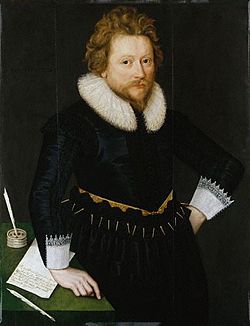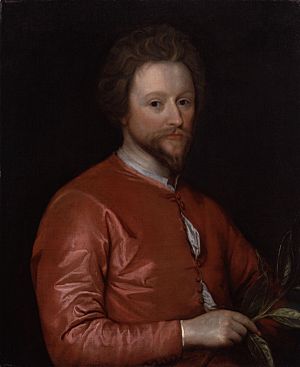John Fletcher (playwright) facts for kids
Quick facts for kids
John Fletcher
|
|
|---|---|
 |
|
| Born | December 1579 Rye, Sussex, England |
| Died | August 1625 (age 45) London, England |
| Occupation | Writer |
| Nationality | English |
| Period | 16th–17th centuries (Jacobean) |
| Genre | Drama |
John Fletcher (1579–1625) was a famous English writer of plays during the Jacobean era. This was a time when King James I ruled England. After William Shakespeare, Fletcher became the main playwright for the King's Men, a very popular acting group.
He wrote many plays and was very important in his time. Some people even thought he was as famous as Shakespeare! John Fletcher often worked with other writers. He wrote plays with Francis Beaumont and even helped Shakespeare with three plays.
Fletcher's plays helped bridge the gap between the older Elizabethan plays and the newer plays of the Restoration period. Even though he is not as well-known today, he was a key figure in theatre history.
Contents
About John Fletcher
His Early Life
John Fletcher was born in December 1579 in a town called Rye, in Sussex, England. He died in August 1625 from the plague. He was buried in Southwark Cathedral in London.
His father, Richard Fletcher, was a successful church leader. He held important positions like Bishop of London and was a chaplain to Queen Elizabeth. Richard Fletcher was even present at the execution of Mary, Queen of Scots. He prayed loudly and dramatically during the event.
John Fletcher's father died in 1596, leaving the family in debt. John and his seven brothers and sisters were then cared for by their uncle, Giles Fletcher. John went to Corpus Christi College at Cambridge University when he was only eleven. He might have been preparing for a career in the church. However, like other writers of his time, he moved from Cambridge to London to work in the growing theatre world.
Working with Other Playwrights
Around 1606, John Fletcher started writing plays for a children's acting group called the Children of the Queen's Revels. They performed at the Blackfriars Theatre. Early in his career, he worked closely with Francis Beaumont. They wrote plays together for about ten years. They wrote for the children's group and later for the King's Men.
Some stories say they even lived together, sharing clothes. This partnership ended when Beaumont got married and then became ill around 1613.
Becoming a Top Playwright
By this time, Fletcher was working more closely with the King's Men. He even worked with William Shakespeare on some plays. These included Henry VIII, The Two Noble Kinsmen, and a lost play called Cardenio. Fletcher also wrote a play by himself called The Woman's Prize, which was a follow-up to Shakespeare's The Taming of the Shrew.
After Shakespeare died in 1616, Fletcher became the main playwright for the King's Men. He wrote only for them until his own death nine years later. He still loved to work with others, writing with Nathan Field and later with Philip Massinger. Massinger took over as the main playwright for the King's Men after Fletcher.
Fletcher was very popular during his lifetime. In 1621, three of his plays were performed for the royal court. He died in 1625, likely from the plague. He is thought to be buried in Southwark Cathedral, possibly in the same grave as Massinger. There are two simple stones in the cathedral floor, one for Shakespeare's younger brother and one for John Fletcher.

Fletcher was especially good at two types of plays: tragicomedies and comedies of manners.
His Plays on Stage
Fletcher's first play, The Faithful Shepherdess, did not do well when it was performed in 1608. It was a type of play called a pastoral tragicomedy. Fletcher explained that the audience expected something different. They wanted more dances, jokes, and even murders.
Fletcher wrote that a tragicomedy is not about being funny or having killings. Instead, it is a play that does not have deaths, so it is not a tragedy. But it brings characters close to death, so it is not just a comedy either. He was trying to create a new style of theatre.
By 1609, Fletcher found his stride. He wrote Philaster with Beaumont, and it was a huge success for the King's Men. This play also started a trend for tragicomedies. Fletcher's influence even inspired some parts of Shakespeare's later plays.
By the mid-1610s, Fletcher's plays were as popular as Shakespeare's. This helped the King's Men become the most important acting company in London. After Beaumont retired and died, Fletcher kept writing alone and with others. He wrote or was credited with almost fifty plays by the time he died in 1625. His plays remained a big part of the King's Men's performances until theatres closed in 1642.
When theatres reopened in 1660, Fletcher's plays were the most common ones performed. People especially liked his comedies of manners. Over time, Shakespeare's plays became more popular. By the late 1700s, only a few of Fletcher's plays were still performed regularly. Today, his plays are mostly studied by experts, with only occasional performances.
How His Plays Were Written
John Fletcher often worked with other writers. This makes it hard to know exactly which parts of a play he wrote. He collaborated most often with Beaumont and Massinger, but also with Shakespeare and others. Some plays he wrote early on were even changed later by Massinger.
Scholars have tried to figure out which writer wrote which parts of the plays. They look for special ways Fletcher used words. For example, he often used ye instead of you and ‘em for them. He also sometimes added an extra stressed syllable to a line of poetry, like sir or too. By looking for these patterns, researchers try to identify his writing style.
However, some scholars say it is hard to be completely sure about who wrote what based only on these patterns. Still, these methods help us learn more about how plays were written in that time.
Here is a list of some of the plays Fletcher wrote, either by himself or with others:
Plays Written Alone
- The Faithful Shepherdess, a pastoral play (written 1608–09)
- Valentinian, a tragedy (1610–14)
- Monsieur Thomas, a comedy (around 1610–16)
- The Woman's Prize, or The Tamer Tamed, a comedy (around 1611)
- Bonduca, a tragedy (1611–14)
- The Chances, a comedy (around 1613–25)
- Wit Without Money, a comedy (around 1614)
- The Mad Lover, a tragicomedy (performed 1617)
- The Loyal Subject, a tragicomedy (licensed 1618)
- The Humorous Lieutenant, a tragicomedy (around 1619)
- Women Pleased, a tragicomedy (around 1619–23)
- The Island Princess, a tragicomedy (around 1620)
- The Wild Goose Chase, a comedy (around 1621)
- The Pilgrim, a comedy (around 1621)
- A Wife for a Month, a tragicomedy (licensed 1624)
- Rule a Wife and Have a Wife, a comedy (licensed 1624)
Plays Written with Others
With Francis Beaumont:
- The Woman Hater, a comedy (1606)
- Cupid's Revenge, a tragedy (around 1607–12)
- Philaster, or Love Lies a-Bleeding, a tragicomedy (around 1609)
- The Maid's Tragedy, a tragedy (around 1609)
- A King and No King, a tragicomedy (1611)
- The Captain, a comedy (around 1609–12)
- The Scornful Lady, a comedy (around 1613)
- Love's Pilgrimage, a tragicomedy (around 1615–16)
- The Noble Gentleman, a comedy (around 1613)
With Beaumont and Massinger:
- Thierry and Theodoret, a tragedy (around 1607)
- The Coxcomb, a comedy (around 1608–10)
- Beggars' Bush, a comedy (around 1612–13)
- Love's Cure, a comedy (around 1612–13)
With Massinger:
- Sir John van Olden Barnavelt, a tragedy (1619)
- The Little French Lawyer, a comedy (around 1619–23)
- A Very Woman, a tragicomedy (around 1619–22)
- The Custom of the Country, a comedy (around 1619–23)
- The Double Marriage, a tragedy (around 1619–23)
- The False One, a history play (around 1619–23)
- The Prophetess, a tragicomedy (licensed 1622)
- The Sea Voyage, a comedy (licensed 1622)
- The Spanish Curate, a comedy (licensed 1622)
- The Lovers' Progress or The Wandering Lovers, a tragicomedy (licensed 1623)
- The Elder Brother, a comedy (around 1625)
With Massinger and Field:
- The Honest Man's Fortune, a tragicomedy (1613)
- The Queen of Corinth, a tragicomedy (around 1616–18)
- The Knight of Malta, a tragicomedy (around 1619)
With Shakespeare:
- Henry VIII, a history play (around 1613)
- The Two Noble Kinsmen, a tragicomedy (around 1613)
- Cardenio, a tragicomedy? (around 1613)
With Middleton and Rowley:
- Wit at Several Weapons, a comedy (around 1610–20)
With Rowley:
- The Maid in the Mill (licensed 1623).
With Field:
- Four Plays, or Moral Representations, in One, a morality play (around 1608–13)
With Massinger, Jonson, and Chapman:
- Rollo Duke of Normandy, or The Bloody Brother, a tragedy (around 1617)
With Shirley:
- The Night Walker, or The Little Thief, a comedy (around 1611)
Some plays are hard to be sure about who wrote them. For example, The Nice Valour might have been revised by Thomas Middleton. The Fair Maid of the Inn might have been written by Massinger, John Ford, and John Webster, possibly with Fletcher.
The first collection of plays by Beaumont and Fletcher was published in 1647. It included 35 plays. A second collection in 1679 added 18 more, making a total of 53 plays.
See also
 In Spanish: John Fletcher para niños
In Spanish: John Fletcher para niños

